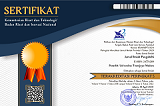Penerapan Teknologi Terpadu Pro-Organik Pada Budidaya Tanaman Padi di Kecamatan Jetis Kabupaten Ponorogo
Abstract
Fertilizer is a substance that provides nutrients for plants. Deficiency of fertilizer results in stunted plant growth and development. Therefore with the condition of the scarcity of chemical fertilizers that occurs in Indonesia decrease of productivity. This is impact in the government's efforts to promote the pro-organic movement. One of the pro-organic movement is learning through field schools (SL) about integrated pro-organic technology in rice cultivation. Integrated pro-organic technology thaat includes the use of organic fertilizer, biological agents/local microorganisms, botanical pesticides and biosaka. This SL activity is carried out as a form of community service in overcoming the problem of scarcity and farmers' dependence on chemical fertilizers. Besides that, integrated pro-organic technology is also expected to be able to maintain the stability of rice plant productivity. The aim of this community service is to maintain the productivity of rice plants with integrated pro-organic technology. This activity was implemented in 10 farmer groups in Jetis District, Ponorogo Regency. The method used is learning and practice through field schools about integrated pro-organic technology which includes organic fertilizer, biological agents/local microorganisms, vegetable pesticides, and Biosaka. Furthermore, rice cultivation using integrated pro-organic technology in 10 farmer groups. The results of the application of integrated pro organic technology showed that integrated pro organic technology is able to maintain and increase the productivity of rice plants by 7.49 tonnes/ha compared to rice cultivation without pro organic technology of 7.22 tonnes/ha. These results increase the enthusiasm of farmer groups in carrying out pro-organic cultivation in the midst of a scarcity of fertilizer
Keywords
Full Text:
PDF (Bahasa Indonesia)References
Ahadiyat, Y. R., Widiyawati, I., & Fauzi, A. (2021). Penerapan sistem pertanian organik dengan aplikasi pupuk organik cair urin kelinci pada padi sawah. Agrokreatif: Jurnal Ilmiah Pengabdian Kepada Masyarakat, 7(3), 221-228.
Amalia, K., & Asnur, P. (2021). Pembuatan Pupuk Organik Cair dari Daun Kelor. Jurnal Akar Volume, 1(2), 9–16.
Arafah, M. S., Setiawati, M. R., & Nurbaity, A. (2017). Pengaruh pupuk organik (Azolla pinnata) terhadap C-organik tanah, serapan N dan bobot kering tanaman padi (Oryza sativa L.) pada tanah dengan tingkat salinitas tinggi. Jurnal Agroekoteknologi, 9(1).
Apriani, M., Rachmina, D., & Rifin, A. (2018). Pengaruh tingkat penerapan teknologi pengelolaan tanaman terpadu (PTT) terhadap efisiensi teknis usahatani padi. Jurnal Agribisnis Indonesia (Journal of Indonesian Agribusiness), 6(2), 119-132.
Basu, A., Prasad, P., Das, S. N., Kalam, S., Sayyed, R. Z., Reddy, M. S., & El Enshasy, H. (2021). Plant growth promoting rhizobacteria (PGPR) as green bioinoculants: recent developments, constraints, and prospects. Sustainability, 13(3), 1140.
Bertham, Y. H., Hidnarto, K. S., & Nusantara, A. D. (2022). Effect Of Biodive Fertilizer On N, P, And K Nutrition Status And Growth And Result Of Two Gogo Rice Varieties In Coastal Area. Journal of Tropical Mycorrhiza, 1(2), 69-78.
Hasanah, J., Rondhi, M., & Hapsari, T. D. (2018). Analisis Risiko Produksi Usahatani Padi Organik di Desa Rowosari Kecamatan Sumberjambe Kabupaten Jember. Jurnal Agribisnis Indonesia (Journal of Indonesian Agribusiness), 6(1), 37-48.
Heryadi, D. Y., Noor, T. I., & Hamdani, J. S. (2022). Implementatif Agribisnis Padi Organik Berkelanjutan Melalui Pendekatan Pentahelix. Jurnal Agribest, 6(1), 1-10.
Imansyah, A. A., & Andreyuni, F. D. A. (2020). Identifikasi Morfologi Benih Padi Sawah Varietas Pandanwangi Di Lima Lokas Kecamatan. Jurnal Pro-Stek Vol, 2(1).
Iswahyudi, Izzah. A, & Ainun. 2020. Studi Penggunaan Pupuk Bokashi (Kotoran Sapi) Terhadap Tanaman Padi, Jagung & Sorgum. CEMARA. 17 (1).14-20
Kasworo, B. A. (2013). Pengelolaan Peternakan Sapi Potong yang Berkelanjutan di Desa Jogonayan Kecamatan Ngablak Kabupaten Magelang (Doctoral dissertation, Program Magister Ilmu Lingkungan).
Khairizal, K., & Azharuddin, A. (2014). Analisis Efisiensi Faktor Produksi Usahatani Padi Sawah Sri Organik Dan An-Organik Di Desa Kelayang Kecamatan Rakit Kulim Kabupaten Indragiri Hulu. Dinamika Pertanian, 29(3), 271-282.
Maruapey, A., & Ali, A. (2023). Application of Cow Manure Compost to Improve Growth and Yield of Paddy Rice (Oriza sativa L.) Mahsuri Variety. Agrikan Jurnal Agribisnis Perikanan, 16(2), 165-174.
Nadalia, D., Hidayat, Y., & Purwakusuma, W. (2024). Sosialisasi Budidaya Padi Organik Dataran Tinggi di Kabupaten Tasikmalaya. Agrokreatif: Jurnal Ilmiah Pengabdian kepada Masyarakat, 10(1), 51-58.
Novianto, F. W., & Setyowati, E. (2009). Analisis produksi padi organik di Kabupaten Sragen tahun 2008. Jurnal Ekonomi Pembangunan: Kajian Masalah Ekonomi dan Pembangunan, 10(2), 267-288.
Putra, D. P., Ferhat, A., Nugraha, N. S., Bimantio, M. P., & Rahman, J. S. (2022, July). Optimalisasi Lahan Sawah Dengan Teknologi Pupuk Organik Carbontiliser. In Prosiding Seminar Nasional Instiper (Vol. 1, No. 1, pp. 94-104).
Ratriyanto, A., Widyawati, S. D., Suprayogi, W. P., Prastowo, S., & Widyas, N. (2019). Pembuatan pupuk organik dari kotoran ternak untuk meningkatkan produksi pertanian. SEMAR (Jurnal Ilmu Pengetahuan, Teknologi, Dan Seni Bagi Masyarakat), 8(1), 9-13.
Suprapti, I., Wulandari, S. E., Agustina, N. W., Putri, M. D., Arifin, A., Toha, E., & Romadhoni, A. H. (2023). Penerapan Teknologi Inovasi Pembuatan Pupuk Biosaka di Desa Ellak Laok Kecamatan Lenteng Kabupaten Sumenep. Jurnal Ilmiah Pangabdhi, 9(1), 16-21.
DOI: https://doi.org/10.21107/pangabdhi.v11i1.23380
Refbacks
- There are currently no refbacks.
Copyright (c) 2025 Lisa Navitasari

This work is licensed under a Creative Commons Attribution-ShareAlike 4.0 International License.
Jurnal Ilmiah Pangabdhi by Universitas Trunojoyo Madura is licensed under a Creative Commons Attribution-ShareAlike 4.0 International License.













